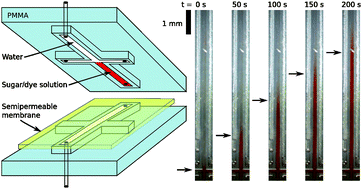Osmotically driven flows in microchannels separated by a semipermeable membrane
Abstract
We have fabricated lab-on-a-chip systems with microchannels separated by integrated membranes allowing for osmotically driven microflows. We have investigated these flows experimentally by studying the dynamics and structure of the front of a sugar solution travelling in 200 µm wide and 50–200 µm deep microchannels. We find that the sugar front travels at a constant speed, and that this speed is proportional to the concentration of the sugar solution and inversely proportional to the depth of the channel. We propose a theoretical model, which, in the limit of low axial flow resistance, predicts that the sugar front should indeed travel with a constant velocity. The model also predicts an inverse relationship between the depth of the channel and the speed, and a linear relation between the sugar concentration and the speed. We thus find good qualitative agreement between the experimental results and the predictions of the model. Our motivation for studying osmotically driven microflows is that they are believed to be responsible for the translocation of sugar in plants through the phloem sieve element cells. Also, we suggest that osmotic elements can act as on-chip integrated pumps with no movable parts in lab-on-a-chip systems.


 Please wait while we load your content...
Please wait while we load your content...